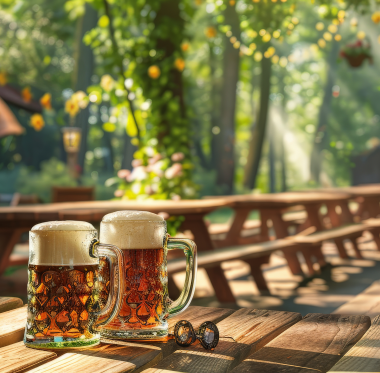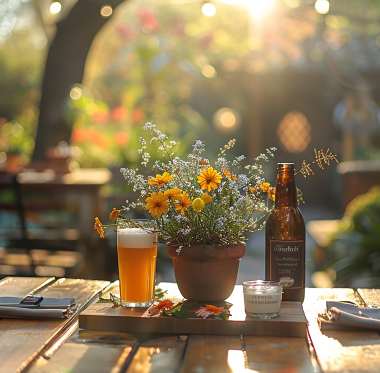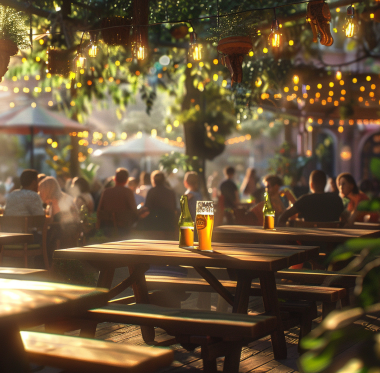reating a beer garden involves designing an outdoor space that is both inviting and functional, providing a relaxed and enjoyable environment for patrons to enjoy beer and socialize. Here’s a comprehensive guide to designing and setting up a successful beer garden:
1. Concept and Theme
- Theme: Decide on a specific theme, such as traditional Bavarian, modern rustic, or urban chic. This will guide your choice of décor, furniture, and overall ambiance.
- Target Audience: Identify your target demographic, such as families, young professionals, or tourists, and tailor the design and offerings accordingly.
2. Location and Layout
- Site Selection: Choose a location with good foot traffic and visibility. Ensure it has enough space to accommodate seating, a bar area, and any additional features.
- Space Planning: Design the layout to facilitate easy movement and comfortable seating arrangements. Include both shaded and sunny areas, and ensure there are clear paths for staff and patrons.
3. Seating and Furniture
- Tables and Benches: Use sturdy, weather-resistant tables and benches. Traditional long wooden tables with benches are common, but consider a mix of seating options to cater to different groups.
- High Tops and Bar Stools: Include high-top tables and bar stools near the bar area for a casual seating option.
- Comfort: Provide comfortable seating with cushions or pillows, especially for longer stays.
4. Bar and Serving Areas
- Bar Design: Create a central bar area that is easily accessible from all seating areas. Use materials like wood or metal that complement the overall theme.
- Service Stations: Consider additional service stations or mobile carts to reduce wait times during peak hours.
- Beer Selection: Offer a variety of beers, including local craft brews, traditional options, and seasonal specials. Provide detailed descriptions and tasting notes.
5. Decor and Ambiance
- Lighting: Use string lights, lanterns, and ambient lighting to create a warm and inviting atmosphere in the evening. Ensure pathways and key areas are well-lit for safety.
- Greenery: Incorporate plants, trees, and flowers to create a lush, garden-like environment. Use planters, hanging baskets, and vertical gardens to maximize green space.
- Thematic Decor: Add elements like beer barrels, rustic signs, and outdoor art to enhance the theme.
6. Weather Considerations
- Shade and Shelter: Provide ample shade with umbrellas, pergolas, or awnings. Consider installing retractable canopies or tents for protection against rain.
- Heating and Cooling: Use outdoor heaters or fire pits for cooler weather and fans or misters for hot days to ensure year-round comfort.
- Drainage: Ensure proper drainage to prevent water accumulation and maintain a dry, comfortable environment.
7. Food and Beverage Service
- Food Menu: Offer a menu that complements the beer selection, such as pretzels, sausages, burgers, and other pub fare. Include vegetarian and vegan options to cater to all patrons.
- Pairings: Provide beer and food pairing suggestions to enhance the dining experience.
- Self-Service Options: Consider self-service kiosks or QR code menus to streamline ordering and reduce wait times.
8. Entertainment and Activities
- Live Music: Schedule live music performances or DJ sets to attract patrons and create a lively atmosphere.
- Games and Activities: Provide games like cornhole, darts, and giant Jenga to encourage social interaction and keep patrons entertained.
- Events: Host themed events, beer tastings, and seasonal festivals to draw crowds and create a dynamic environment.
9. Safety and Accessibility
- Safety Measures: Ensure the space is safe with non-slip flooring, sturdy furniture, and clear walkways. Provide ample lighting and visible emergency exits.
- Accessibility: Make the beer garden accessible to all patrons, including those with disabilities. Ensure pathways and seating areas are wheelchair-friendly.
- Hygiene: Maintain high standards of cleanliness with regular cleaning schedules and easily accessible hand sanitizers.
10. Sustainability
- Eco-Friendly Practices: Implement sustainable practices, such as using recyclable materials, minimizing single-use plastics, and composting organic waste.
- Energy Efficiency: Use energy-efficient lighting and equipment to reduce environmental impact.
- Local Sourcing: Source beers and ingredients from local suppliers to support the community and reduce carbon footprint.
11. Marketing and Community Engagement
- Branding: Develop a strong brand identity that reflects the theme and atmosphere of the beer garden. Use consistent branding across signage, menus, and online presence.
- Social Media: Promote the beer garden on social media platforms with engaging content, event announcements, and customer interactions.
- Community Events: Engage with the local community by hosting events, collaborating with local breweries, and supporting local causes.
By carefully considering these elements, you can create a vibrant and successful beer garden that offers a unique and enjoyable experience for patrons.




© All Copyright 2024 by Kingston Hills. Design by Designinghubworld.in


